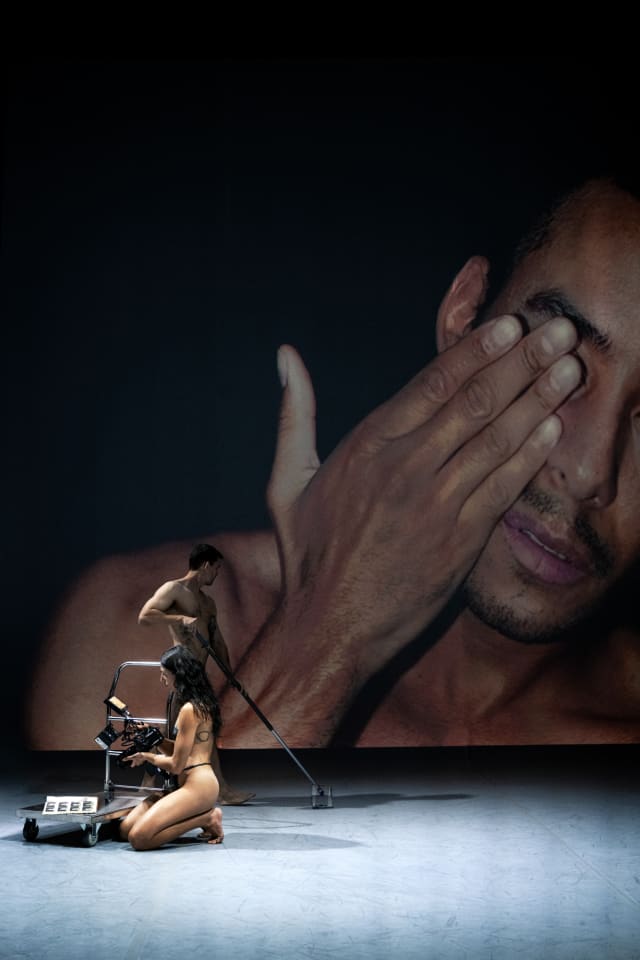Words by Giordana Patumi.
Exposure, a collaboration between Alexandra Bachzetsis and the acclaimed Cullberg dance company, was performed earlier this month at the Gessnerallee in Zürich, Switzerland. The work —provocative, visceral and layered — offered a bold interrogation of the human body’s role in contemporary visual and performative culture. Bachzetsis, known for her interdisciplinary approach that bridges dance, performance art and visual culture, created a piece that was as intellectually engaging as it was emotionally resonant.
At its core, Exposure dissected the paradoxes of bodily representation. The performance delved into themes of nudity versus clothing, intimacy versus alienation and vulnerability versus power. It reframed the human form as both an object of desire and a medium of resistance. The dancers examined these tensions with relentless physicality, moving through sequences that captured everyday gestures, acts of exhaustion and moments of extreme exposure. The choreographic language oscillated between hyper-controlled precision and raw, unfiltered release, creating a sense of constant flux.
Bachzetsis’s dramaturgy pushed the audience to confront how societal norms, media and digital culture shape perceptions of the body. The dancers embodied this critique by juxtaposing elements of pop culture — such as references to fashion and social media — with deeply personal, corporeal expressions. These collisions underscored the duality of the body as both a site of cultural inscription and a vessel for agency.
Cullberg’s dancers brought exceptional depth and versatility to the piece. Each performer was a master of duality, embodying moments of profound intimacy and commanding presence and stood out for their ability to seamlessly shift between fluid, lyrical movement and confrontational physicality. They conveyed vulnerability and resilience in equal measure, adding layers of complexity to the ensemble’s dynamic.

The collaboration with the dancers extended beyond execution. Bachzetsis’s creative process emphasised the performers’ individual voices, and their contributions were palpable throughout the work. Each body on stage was both an individual entity and part of a collective whole, creating a dynamic interplay that heightened the piece’s emotional and conceptual impact.
The production’s minimalist aesthetic was a study in contrasts. The stark, unadorned stage served as a blank canvas for the dancers, while lighting and video projections by Ivan Wahren amplified the thematic undercurrents. The shifting lights cast shadows that at times fragmented the performers’ bodies, reinforcing the idea of the body as both a subject and object of representation. Projections of digital imagery added another layer, blurring the line between the real and the mediated. The soundscape, designed by Alban Schelbert, was equally evocative. It ranged from pulsating electronic beats to moments of eerie silence, punctuated by excerpts from pop songs like “Our Love” by R.W. Fassbinder. The music amplified the choreography’s emotional texture, drawing the audience deeper into the performance’s shifting moods.
Exposure was more than a dance performance; it was a choreographic statement that challenged conventions and invited reflection. Bachzetsis’s ability to weave together elements from diverse disciplines — dance, theater, visual art, and digital culture— was a testament to her innovative vision. The piece asked probing questions about the ways in which bodies are consumed, controlled and celebrated in contemporary society.
One of the most striking aspects of the performance was its embrace of ambiguity. Rather than offering clear resolutions, Exposure allowed gestures and actions to linger, compelling the audience to sit with discomfort and complexity. This endurance-based approach mirrored the vulnerability of the performers, who laid bare their physical and emotional limits on stage.
For us audience, the experience was deeply immersive. The performance broke down traditional barriers between spectator and performer, inviting the audience to engage with the work on a visceral level. Moments of prolonged eye contact and near-stillness created an intimacy that was both unsettling and profound.
The post-performance discussion with Bachzetsis and collaborators added another dimension, offering insights into the creative process and thematic intent. This dialogue underscored the collaborative spirit of the production and deepened the audience’s appreciation for its layered meanings.
Exposure reaffirmed Alexandra Bachzetsis’s reputation as a visionary choreographer and Cullberg’s status as a leading contemporary dance company. It was a performance that defied categorisation, blending movement, imagery and sound into a cohesive yet multifaceted whole. For dancers and dance enthusiasts, it was a masterclass in pushing the boundaries of the art form. For all who witnessed it, Exposure was a provocative meditation on the human body’s power to reveal, resist, and transform.
